The current show at Zhulong Gallery is not something that I’d typically write about; I rarely write about painting (I tend to focus on media-based and performance work). But since Zhulong’s mission is about the confluence of art, media and technology, I took up its connection to abstract painting for this show.
The show’s title, Phantom Eye, refers to the phrase “phantom limb,” i.e. how a person missing a body part experiences the sensation that the missing part is still with them. Jimmy Baker and Matthew Hillock’s Phantom Eye proposes ways of seeing things that may be absent or only exist as memories.
Both artists use appropriated images as source material, harvesting and archiving images and text from Google searches and current events. Their work has visual similarities, so I was surprised to learn that prior to the exhibit, neither artist was aware of the other’s work, nor did they collaborate on any aspect of the show.
The conceptual and formal transformations that occur during the creative process is what interests me most about their work. Jimmy Baker combines painting and a digital printing process, and the densely layered canvases require a lot of work on the viewer’s part to dissect and decode the different patterns, marks and images. The paintings tend to obscure as much as they reveal, but the artist uses titles as clues to his conceptual framework.
The gallery features works from two series titled Legacy System and Sieves, both created in 2015. A legacy system refers to an outdated computer program or application, and the self-deprecating humor of the title suggests an inner conflict by the artist as to the relevancy of painting today. The mingling of digital printing with painting also calls up the old argument about ‘original’ verses ‘reproduction,’ and how these face different valuation in the market. The sieve, as a symbol for “weeding out” undesirable debris, is also a metaphor for how we as a society—and the artist as an individual—edit and make sense of the media bombardment we deal with daily. A lot of contemporary painters combine digital transfer printing with their work, but rarely have I seen it executed this subtly and humorously.
Matthew Hillock’s work here includes video paintings and a series of large 2D works. Unlike Baker’s work, a personal narrative provides the conceptual structure for Hillock’s process. (For example, his piece “Deep Fried in Dallas” was derived from the artist’s visit to Dallas when he almost died of heat stroke.) Hillock feeds descriptive phrases into Google, ones derived from his own experiences, and gathers the resulting memes. From those, he creates a digital collage of 250-300 layers. This is his beginning source material for the 2D and video works. For the videos he uses a 3D modeling program to transform the collages into moving, digital paintings. He paints digitally using a Wacum tablet. Wave-like motions repeat throughout the video paintings representing the ups and downs of the artist’s personal narrative, and the motion also emulates the gestural arm movement of painting. The resulting videos are hypnotic, colorful abstractions of utopic landscapes.
Hillock enters another transformative stage by creating a UV map from the video. UV mapping is the 3D modeling process of making a 2D image from the 3D model’s surface, like a topographical map. These works are printed on Dibond aluminum. Expansion and collapse happens spatially with the transformation between 2D to 3D (and in theory, 4D), back to 2D. The UV map images are the most minimal and abstract of all the various work permutations, resembling distant satellite maps or a hidden code.
I spoke to Hillock, and remarked that understanding the “back story” or the phantom-eye aspect of his work is essential, in that otherwise there’s a risk that viewers might mistake the work as devoid of content or purely decorative. I wondered aloud about his decision to transform his deeply personal narratives and emotions into an animated abstract landscape. Does this distillation dehumanize the personal? Does the “cartoon” aspect of the work serve as a caricature? Perhaps it comments on our desire to translate the personal into the universal through our engagement with technology.
After mulling over these questions for the last few days, I think both Baker and Hillock successfully avoid placing value judgments on Internet culture (which tends to be an easy target for many artists today) and instead use the tools as a generative means to create new forms and distill ideas. Besides the phantom-limb reference, the Phantom Eye is also the name of a drone marketed by Boeing for its “…persistent intelligence, surveillance and reconnaissance and communications missions.” Baker and Hillock are omniscient surveyors of sorts: trolling, culling and recovering pieces of cultural memory, while imagining and producing new kinds.
Jimmy Baker and Matthew Hillock at Zhulong Gallery through August 8.


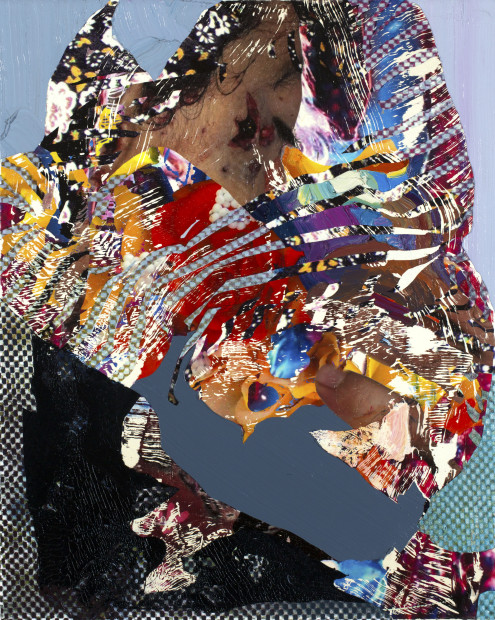
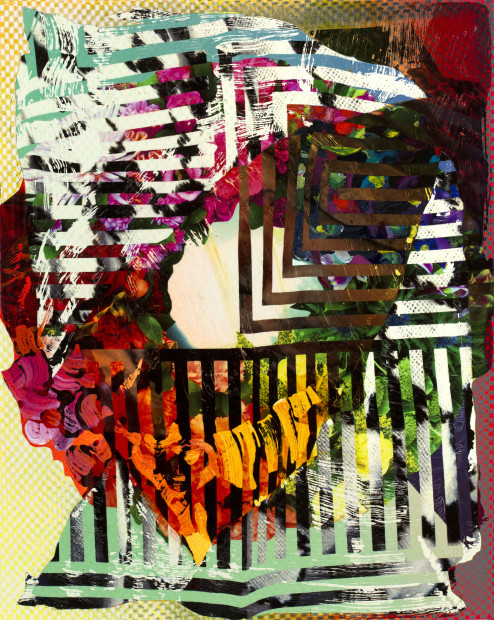
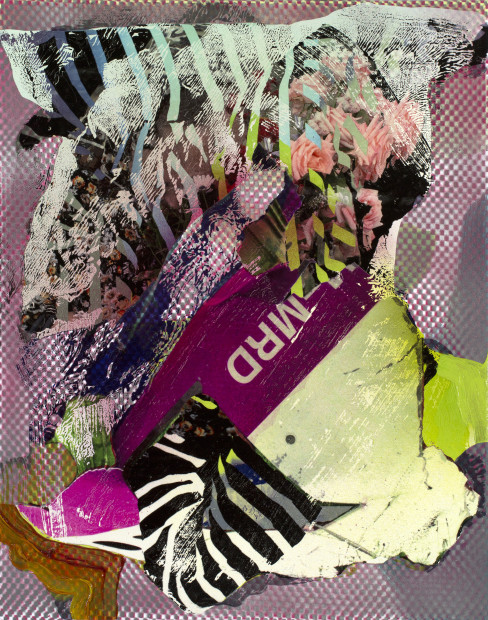
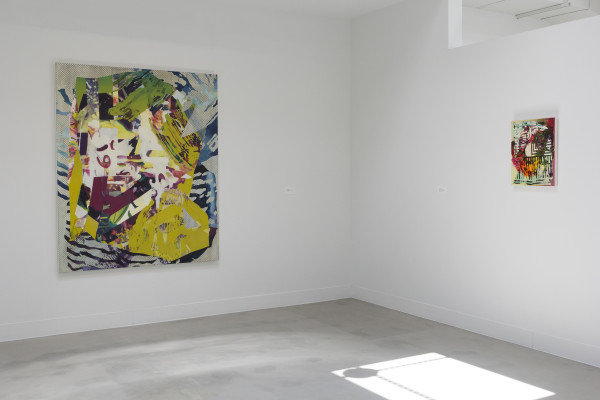
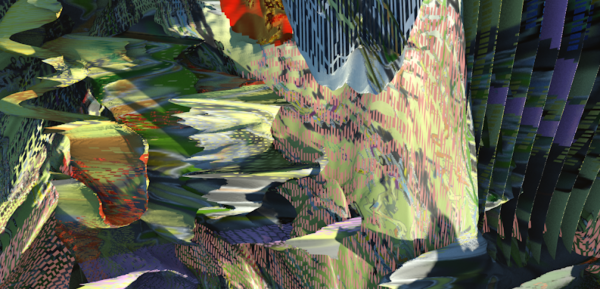
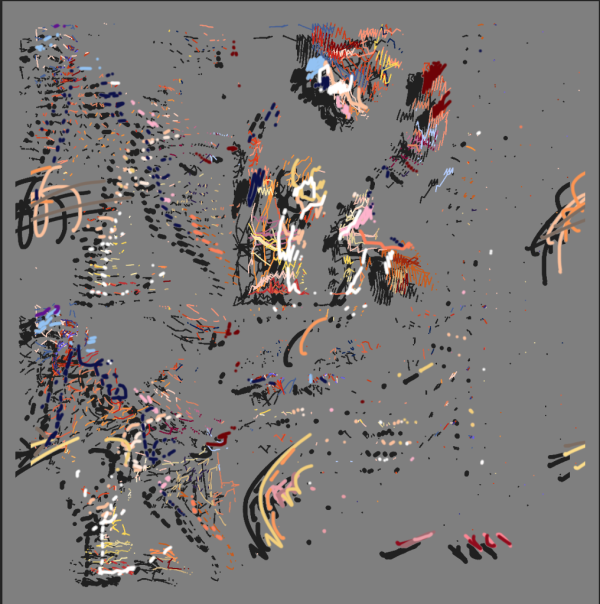

4 comments
Hi Colette,
When you spoke to them you revealed your thinking, I’m curious about theirs–” what were they thinking? “in that otherwise there’s a risk that viewers might mistake the work as devoid of content or purely decorative…ouch.
“I wondered aloud…” ( and where was the artist’s thinking…)…”transform his deeply personal narratives”…ouch.
and then the best line in your thinking,:.. “Perhaps it comments on our desire to translate the personal into the universal through our engagement with technology.” Great Line there and for that line the rest should be edited and still I wonder what does the artist think? Thanks, Rosanne
Thank you for your comments Rosanne. My comments about Hillock’s work were not meant to be dismissive or negatively critical as suggested by your “ouch” responses. My purpose in bringing those up was to emphasize the importance of conceptual framework to his work. Without understanding the personal narrative source material and his process that drives the work as well as the larger connection to cultural engagement with technology, some viewers would miss the subtle, yet complex nuances found in his work. When I “wondered aloud” to Hillock about using such deeply personal stories, that is because it makes the artist vulnerable. If you are familiar at all with my work, you know that I have a deep connection to personal narrative and history. In Hillock’s and my conversation, he agreed that viewers might not take the time to engage beyond a superficial level. In terms of phantom eye–using a personal narrative fits that metaphor, since once the story is out in the public, and becomes collective, a part of the individual is lost.
I can see where some extra thought is needed to interpret these pictures. I appreciated your insight and the thoughts of the artist when the pictures were made. It’s very helpful to get inside the artist’s head. Thank you for the review and sharing the art!
Mahée–Thank you for your kind comments. I do think that both of these artists’ work deserve extra thought. I find I’m most drawn to work that allows for open interpretation, while grounded in strong conceptual and visual rigor.